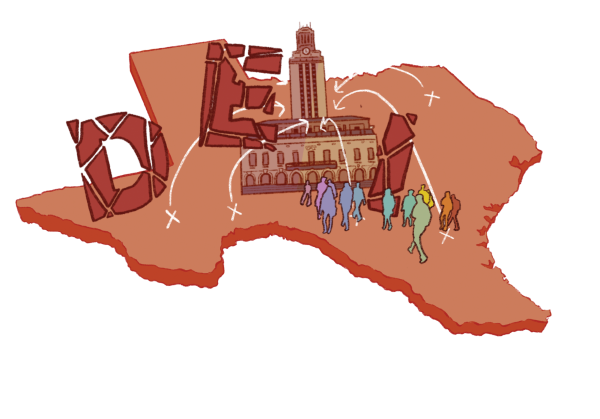AISD Educators Exit in a Mass Exodus
October 17, 2022
According to the Texas Tribune, 8,600 Texas teachers quit their jobs in 2021, which is over the state average of 7,500. Because of this, many students came back from the COVID-19 pandemic to classrooms without a permanent teacher.
Austin Independent School District (AISD) is currently experiencing a teacher shortage, but difficulty hiring and retaining teachers is not uncommon. According to the University of Pennsylvania, nearly half of all teachers leave the profession after just five years, and the National Center for Education Statistics estimates that eight percent of teachers quit every year.
This is especially common for special education (special-ed) teachers, who deal with students with disabilities and are often put under more pressure and have higher workloads. One such teacher is LeAnn Pigulski, an occupational therapist for AISD and special-ed teacher.
“There’s a lot less teachers in special-ed,” Pigulski said. “A lot of teachers are trying to get either out of special-ed or out of teaching entirely, even young teachers. A lot of teachers are taking early retirement.”
Pigulski has been working for the district for seven years. She said things have changed since she started, especially with the COVID-19 pandemic.
“We’re on our third software system since I started special-ed,” Pigulski said. “We have had many different administrators. COVID[-19] threw everyone for a loop.”
LASA English teacher Caroline Pinkston said the overall community attitude towards virtual school and teachers during the pandemic switched back and forth between positive and negative commentary. She said teachers felt like they were doing a lot to adjust which wasn’t always recognized.
“At the beginning of the pandemic, there was a lot of talk of teachers being heroes,” Pinkston said. “Because we were doing all this great stuff, but that turned really quickly into frustration with teachers for not being willing to come right back into buildings, or for complaining about workload.”
Pinkston believes that the COVID-19 pandemic was one of the main causes of the teacher shortage. She said the switch to virtual school overworked teachers, and many teachers felt there wasn’t enough concern for their wellbeing.
“For everybody that was a really bad feeling, to feel like nobody really cared if we were put in a safe position or not,” Pinkston said. “And I also think that was the turning point, in terms of teachers feeling really attacked.”
Former LASA teacher Nathan Wong said that he left teaching because of the way decisions are made in the district. In AISD, teachers don’t get a say in the majority of policy decisions that affect teachers, according to Wong.
“The things that need to be fixed can’t get fixed on our level,” Wong said. “Students, and teachers, and principals, we’re the ones who all these decisions affect, but none of us actually make those decisions. It’s people who are not even involved in school, and haven’t been in school in ages.”
Wong also mentioned how teachers’ workloads keep increasing. He said that teachers used to have 25 students per class, and now that’s closer to 35.
“We can’t keep growing classrooms more and more,” Wong said. “That’s just more and more hours of prep, more and more hours of grading.”
Lindsey Ramirez is a physical therapist in the district. She also touched on the amount of work teachers are having to do.
“Administration places a lot on [the teachers’] plate and never takes anything off,” Ramirez said. “It just becomes overwhelming, and you don’t feel like a good teacher anymore.”
Pinkston said that the workload in teaching is likely the main cause of the shortage. She said that teachers have an average of 170 students this year, which is more than previous years.
“The workload… is increasing all the time and becoming unsustainable,” Pinkston said. “We have more grading and more planning, but the pay is not keeping up with that.”
Pigulski also said that pay is probably a driving factor in decisions to leave teaching. She believes that a better salary and more benefits would make a lot of teachers reconsider their decisions to leave.
“It’s one of the lowest paying jobs, still,” Pigulski said. “And oftentimes teachers are working so much extra time out of school hours, or because they don’t get paid enough, they’re working second jobs.”
Ramirez said that it’s difficult to fill certain positions due to low pay. She talked about how many assistant positions have been left empty which takes away individualized help from special-ed students, and further divides the teacher’s attention.
“Some students require a one-on-one, which means they have a dedicated person just attending to their needs,” Ramirez said. “We are not filling all of those positions, and the teaching assistants do not get paid very well.”
Pigulski talked about how the lack of teacher’s assistants is affecting students in special-ed. According to Pigulski, a lot of special-ed teachers have changed careers.
“What that means is that the general ed teacher has a lot more responsibility,” Pigulski said. “She has to help the special-ed kids more than ever before, because there used to be more TAs that could be in her classroom helping her out.”
The shortage is affecting general education students as well. Ramirez has noticed effects of the teacher shortage in her own childrens’ education in kindergarten (kinder) and pre-kindergarten (pre-K) as well.
“I have two children in the school district,” Ramirez said. “One is in kinder and one is in pre-K, and they are both in combined classes because of the shortage. So my kindergartner is in a class with 25 kinder and first-graders… Some students have never been in school before… That’s very challenging for the teacher.”
Pinkston said some solutions to help stop the shortage such as revisiting the ideas of pay and workload. She said teachers should be well-compensated for the time they spend grading and planning outside of class, which only increases as class sizes get larger.
“A meaningful pay increase would make a difference,” Pinkston said. “Working to cap class sizes would make a difference.”
Wong said that a lot of the decisions made by the district make life harder for teachers. He stressed the importance of listening to staff in the future.
“I think being open to hearing from teachers, from students, from principals, having a forum where that’s possible, is really, really important,” Wong said. “I think that would be 10 miles better than just pretending like they know how to make decisions.”










